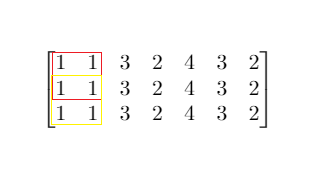1292. Maximum Side Length of a Square with Sum Less than or Equal to Threshold


Description
Given a m x n matrix mat and an integer threshold, return the maximum side-length of a square with a sum less than or equal to threshold or return 0 if there is no such square.
Example 1:

Input: mat = [[1,1,3,2,4,3,2],[1,1,3,2,4,3,2],[1,1,3,2,4,3,2]], threshold = 4 Output: 2 Explanation: The maximum side length of square with sum less than 4 is 2 as shown.
Example 2:
Input: mat = [[2,2,2,2,2],[2,2,2,2,2],[2,2,2,2,2],[2,2,2,2,2],[2,2,2,2,2]], threshold = 1 Output: 0
Constraints:
m == mat.lengthn == mat[i].length1 <= m, n <= 3000 <= mat[i][j] <= 1040 <= threshold <= 105
Solution
maximum-side-length-of-a-square-with-sum-less-than-or-equal-to-threshold.py
class Solution:
def maxSideLength(self, mat: List[List[int]], threshold: int) -> int:
rows, cols = len(mat), len(mat[0])
prefix = [[0] * (cols+1) for _ in range(rows+1)]
for i in range(1, rows+1):
c = 0
for j in range(1, cols + 1):
c += mat[i-1][j-1]
prefix[i][j] = prefix[i-1][j] + c
for k in range(min(rows,cols)-1, -1, -1):
for i in range(1, rows - k + 1):
for j in range(1, cols - k + 1):
if prefix[i+k][j+k] - prefix[i-1][j+k] - prefix[i+k][j-1] + prefix[i-1][j-1] <= threshold:
return k+1;
return 0
maximum-side-length-of-a-square-with-sum-less-than-or-equal-to-threshold.java
class Solution {
public int maxSideLength(int[][] mat, int threshold) {
int m = mat.length, n = mat[0].length;
// Find prefix sum
int[][] prefixSum = new int[m+1][n+1];
for (int i = 1; i <= m; i++) {
int sum = 0;
for (int j = 1; j <= n; j++) {
sum += mat[i-1][j-1];
prefixSum[i][j] = prefixSum[i-1][j] + sum;
}
}
// Start from the largest side length
for(int k = Math.min(m, n)-1; k > 0; k--) {
for(int i = 1; i+k <= m; i++) {
for(int j = 1; j+k <= n; j++) {
if(prefixSum[i+k][j+k] - prefixSum[i-1][j+k] - prefixSum[i+k][j-1] + prefixSum[i-1][j-1] <= threshold) {
return k+1;
}
}
}
}
return 0;
}
}